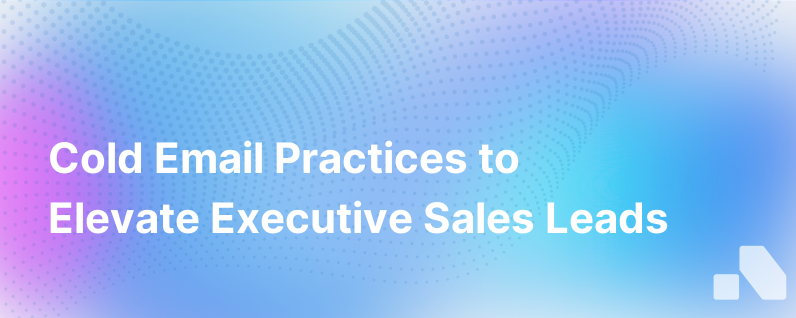
In the digital age, cold emails are a staple of B2B engagement strategies. An effective medium for first-time outreach, cold emails can open the door to meaningful business connections, partnerships, and ultimately, sales. However, standing out in the crowded inboxes of decision-makers is both an art and a science. Crafting the perfect cold email is not just about the content you include, but also how you structure it and engage your prospect.
Here's a deep dive into cold email best practices to help you get the results you're looking for.
The Anatomy of Cold Emails
While every cold email is unique, there are universal elements that should be present in each correspondence:
- Subject Line: This is your first—and possibly last—opportunity to make an impression. Your subject line should be intriguing, clear, and relevant, hinting at the value the recipient will gain from opening your email.
- Personalization: Generic messages get lost in the sea of daily emails. Personalization demonstrates that you’ve taken the time to know your prospect and value them beyond just another lead.
- Introduction: Succinctly introduce yourself and establish credibility. Explain who you are, your role, and why you are reaching out specifically to them.
- Value Proposition: Clearly articulate what’s in it for them. How does your product or service solve a problem they might be facing? Your proposition should be compelling, concise, and focused on benefits rather than features.
- Call To Action (CTA): Direct the recipient to the next step—whether that's a phone call, a demo, or simply a reply. The CTA should be specific and easy to follow.
- Closing and Signature: Politely close your email. Your signature should include your name, position, and company, along with contact information.
Best Practices for Crafting Effective Cold Emails
1. Research Your Prospects
Before sending any emails, know your audience. Research your prospect to identify potential pain points, interests, and business activities that align with your offer. Tailoring your message with relevant references signals to recipients that your outreach is intentional, not random.
2. Keep It Short and Sweet
Your prospects are busy. Writing an email that’s concise but impactful is crucial. Aim to keep your email under 200 words. Each sentence should serve a purpose and add value to your pitch.
3. Start With a Compelling Subject Line
Your subject line can make or break your cold email campaign. Keep it under 50 characters and avoid click-bait-y phrases or over-hyped text that can trigger spam filters. Clarity and relevance will win over flashy language almost every time.
4. Personalize Your Greeting
Address your recipient by name and, if possible, mention a recent accomplishment or news about their company. This level of personalization fosters rapport and shows you’ve done your homework.
5. Demonstrate Value Upfront
Instead of talking about yourself or your company, focus on them. Explain succinctly how your product or service can address a challenge they’re facing or how it could help achieve their goals.
6. Use Social Proof
Instill confidence by mentioning other firms or industry leaders who have benefited from your offer. Social proof can be a strong persuader provided it resonates with your prospect’s industry or situation.
7. Craft a Clear CTA
Your CTA should be impossible to misunderstand. Whether you want them to schedule a call, answer a question, or provide feedback—ensure your request is simple and clear.
8. Follow Email Formatting Best Practices
Formatting matters more than you might think. Breaking your email into short paragraphs, using bullet points, and leveraging whitespace can make your email more readable and engaging.
9. A/B Test Different Approaches
Implement A/B testing to determine which elements of your cold emails resonate best with your target audience. This could include variations in your subject lines, introduction approach, value statements, and CTAs.
10. Track and Measure
Use email tracking tools to gather data on open rates, click-through rates, replies, and conversions. Without this data, you won't know which parts of your cold email strategy are working (or not).
11. Follow Up (But Don’t Spam)
Following up is key in cold emailing but should be done judiciously. Segment your follow-ups based on the response to your first email and tweak the message to continue offering value.
Segment and Personalize
Mass, impersonal email blasts are relics of a less sophisticated internet era. With segmentation, you tailor messages to specific groups based on industry, company size, job title, or where they are in the buyer’s journey. Combined with personalization, segmentation makes for a potent mix.
Writing Style Matters
Your choice of words and writing style is as important as the message itself. Use simple, direct language. Avoid jargon, unless it is commonly used by your audience, and always be respectful and professional.
It’s Not Just About You
Despite being termed ‘cold,’ these emails should aim to warm up the recipient to you and your offer. This means focusing on building a relationship rather than just selling a product or service. Provide insights, share valuable content, or find other ways to be of service before asking for anything in return.
Mind The Law
Before crafting a cold email campaign, ensure you understand laws such as the CAN-SPAM Act in the U.S., GDPR in Europe, or CASL in Canada. Complying with regulations will save your company from hefty fines and ensure your messages are ethical and respectful.
Final Thought
In a world where first impressions are increasingly made within inboxes, mastering the art of cold emailing is vital. By following best practices, using tools to streamline the process, and leveraging platforms like Aomni to glean precise insights, B2B startups can create powerful, effective cold emails that deliver results. Tailor your approach, provide genuine value, and let your company's unique perspective shine. Even a cold email, when crafted with care and precision, can warm its way into a fruitful business relationship.